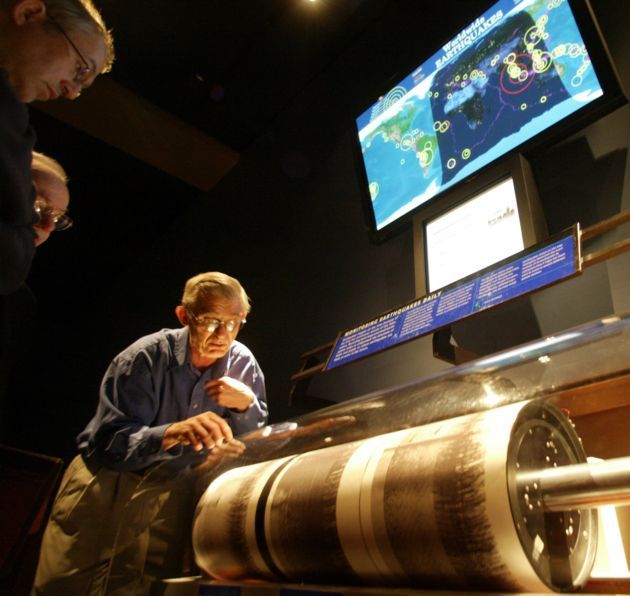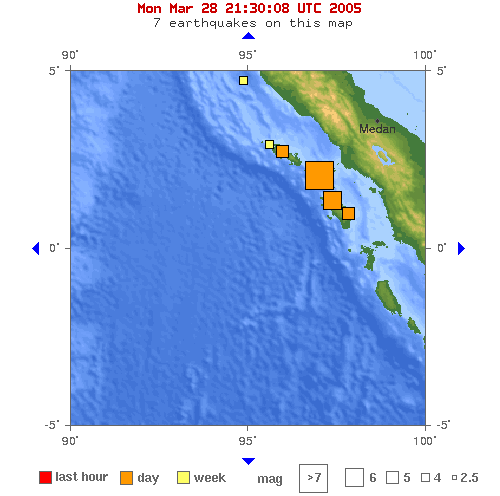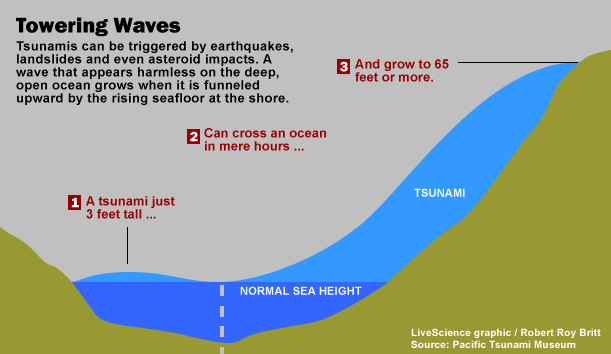Mystery Behind Monday's 'Great' Earthquake

Monday's 8.7-magnitude earthquake off the coast of Sumatra apparently did not generate a significant tsunami, despite originating in the same area as the Dec. 26 earthquake that unleashed towering killer waves across the Indian Ocean.
The reason remains a mystery for now.
"This new event is very significant - what we call a great earthquake," said Jian Lin of the Woods Hole Oceanographic Institution. "Events of this magnitude always have a good chance to create a tsunami."
Nature's fault
Monday's quake occurred about 120 miles southeast of the magnitude 9.3 earthquake of last December. The previous rupture - which had eight times the energy of the one Monday - was on a subduction zone, where the India continental plate slides beneath the Burma plate. This area is also called a thrust, or dip-slip, fault.
"A thrust fault, where one side goes up and one side goes down, is the perfect type for a tsunami," Lin told LiveScience in a telephone interview.
Another type of fault, called strike-slip, involves two plates sliding horizontally with respect to each other. This kind of motion does not generally cause the kind of water displacement, or paddle effect, necessary to create a tsunami.
Sign up for the Live Science daily newsletter now
Get the world’s most fascinating discoveries delivered straight to your inbox.
Lin thought that Monday's event was a thrust fault temblor. "From my experience, a strike-slip would not have been this big," he said.
Two aftershocks to Monday's quake each measured more than magnitude 6. In fact Monday's event is likely to be considered an aftershock to the Dec. 26 temblor, scientists say.
Geologists puzzle over why certain earthquakes of similar magnitude - particularly in the central Pacific - do not unleash tsunamis.
Lin explained that other factors can determine whether a tsunami will form, like the depth at which the rupture occurs.
"Shallower events will have a huge effect," he said.
The December 2004 earthquake originated 6 miles (10 km) below the seafloor. The focus of Monday's quake was 18.6 miles (30 km) down, according to the U.S. Geological Survey. But Lin said that this is misleading, since geologists give this value as a default until they are able to make more precise measurements.
If the earthquake occurred deep in the Earth, then the resulting tsunami could be very small. A buoy monitored by Australian officials indeed detected a small tsunami.
"My suspicion is that [the earthquake] has created a tsunami," Lin said. Other scientists agreed.
Lin said it is likely that satellites or hydrographic stations in the area will later detect tsunami signatures.
Not a surprise
The location of Monday's event could very likely be part of the aftermath of the December catastrophe. Lin explained that the release of stress in one part of a fault can increase stress in another part, increasing the likelihood of an earthquake.
Other geologists had warned just two weeks ago that the December quake added stress to the fault that could cause another very large release of energy at any time.
"We expected that this part of the subduction zone has been stressed by the Dec. 26 earthquake," Lin said. The new earthquake "is not a surprise."
According to Lin, there is a "gap" in this vicinity, which has not experienced a stress-relieving rupture in 400 years. If the recent temblor is on this gap, then four-centuries-worth of pressure might finally have been lifted.
"That could be good news," Lin said. "If this final patch is gone, then the people in that area could get some relief."
But if today's rumblings were on the same part of the fault as the Dec. 23 event, then that final unrelieved patch would be feeling even more pressure now - increasing the likelihood of another rupture.
Geologists will be studying data from the event in coming days in an effort to learn more.
Related Earthquake Stories
Deadliest Earthquakes in History
March is Earthquake Month, and Other Shaky 'Facts'
Central US Warned of Larger Earthquakes to Come
Ominous Rumbling Under San Andreas Fault
Fault Types
Strike-slip faults move horizontally. Normal and reverse faults involve vertical movement. Thrust faults involve angled vertical movement.
CREDIT: USGS
Aftershocks

CREDIT: USGS
Other Information
U.S. Gulf Coast Faces High Tsunami Risk
The Megatsunami: Possible Modern Threat
How Tsunamis Work

Most Popular

